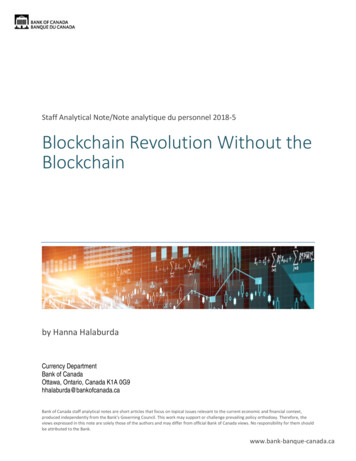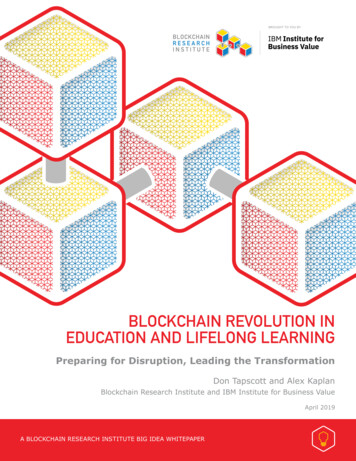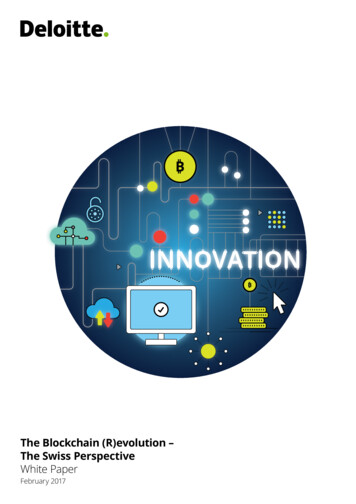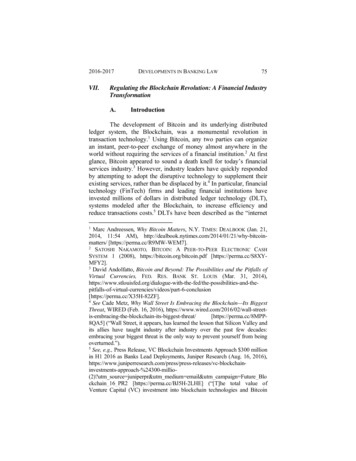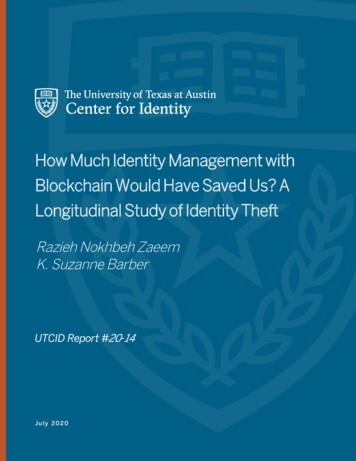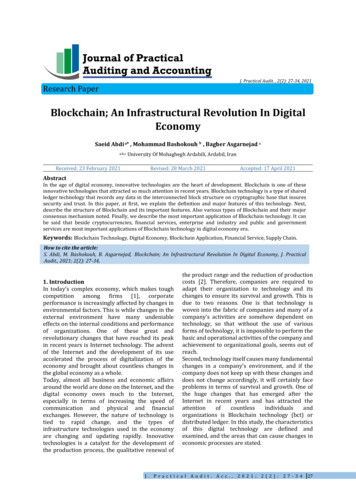
Transcription
J. Practical Audit. , 2(2): 27-34, 2021Research PaperBlockchain; An Infrastructural Revolution In DigitalEconomySaeid Abdi a , Mohammad Bashokouh b , Bagher Asgarnejad ca,b,cReceived: 23 February 2021AbstractUniversity Of Mohaghegh Ardabili, Ardabil, IranRevised: 28 March 2021Accepted: 17 April 2021In the age of digital economy, innovative technologies are the heart of development. Blockchain is one of theseinnovative technologies that attracted so much attention in recent years. Blockchain technology is a type of sharedledger technology that records any data in the interconnected block structure on cryptographic base that insuressecurity and trust. In this paper, at first, we explain the definition and major features of this technology. Next,describe the structure of Blockchain and its important features. Also various types of Blockchain and their majorconsensus mechanism noted. Finally, we describe the most important application of Blockchain technology. It canbe said that beside cryptocurrencies, financial services, enterprise and industry and public and governmentservices are most important applications of Blockchain technology in digital economy era.Keywords: Blockchain Technology, Digital Economy, Blockchain Application, Financial Service, Supply Chain.How to cite the article:S. Abdi, M. Bashokouh, B. Asgarnejad, Blockchain; An Infrastructural Revolution In Digital Economy, J. PracticalAudit., 2021; 2(2): 27-34,1. IntroductionIn today's complex economy, which makes toughcompetition among firms [1], corporateperformance is increasingly affected by changes inenvironmental factors. This is while changes in theexternal environment have many undeniableeffects on the internal conditions and performanceof organizations. One of these great andrevolutionary changes that have reached its peakin recent years is Internet technology. The adventof the Internet and the development of its useaccelerated the process of digitalization of theeconomy and brought about countless changes inthe global economy as a whole.Today, almost all business and economic affairsaround the world are done on the Internet, and thedigital economy owes much to the Internet,especially in terms of increasing the speed ofcommunication and physical and financialexchanges. However, the nature of technology istied to rapid change, and the types ofinfrastructure technologies used in the economyare changing and updating rapidly. Innovativetechnologies is a catalyst for the development ofthe production process, the qualitative renewal ofthe product range and the reduction of productioncosts [2]. Therefore, companies are required toadapt their organization to technology and itschanges to ensure its survival and growth. This isdue to two reasons. One is that technology iswoven into the fabric of companies and many of acompany's activities are somehow dependent ontechnology, so that without the use of variousforms of technology, it is impossible to perform thebasic and operational activities of the company andachievement to organizational goals, seems out ofreach.Second, technology itself causes many fundamentalchanges in a company's environment, and if thecompany does not keep up with these changes anddoes not change accordingly, it will certainly faceproblems in terms of survival and growth. One ofthe huge changes that has emerged after theInternet in recent years and has attracted theattentionofcountlessindividualsandorganizations is Blockchain technology (bct) ordistributed ledger. In this study, the characteristicsof this digital technology are defined andexamined, and the areas that can cause changes ineconomic processes are stated.J. Practical Audit. Acc., 2021; 2(2): 27-34 27
2. Blockchain Fundamentals"We should think about the Blockchain as anotherclass of thing like the internet- a comprehensiveinformation technology with tiered technical levelsand multiple classes of application for any form ofregistry,inventory,andexchange[3].Thissentences from the another of "Blockchain;Blueprint for a New Economy" maybe is thecomprehensive description that state the relevanceof the BCT and its applications , but there is no onedefinition of BCT in literature and every one ofresearchers and contributions has its ownstatement of BCT. However, there are somecommon features and characteristic item thatdescribe BCT. In following at first, give somedefinition from various contributions and thenhighlight the major features of BCT.2.1 DefinitionBlockchain, one of the most important andinnovative technologies developed in recent years[4].Few information technologies are gaining asmuch as attention as Blockchain (BC) [5]. Acrossmost current researches, how Blockchain isdefined is informal, mostly described specifically tothe context of use and using some marketingwords in terms of properties [6]. The generalizedBlockchain technique refers to a new decentralizedcomputational paradigm that uses the encryptedchained block structure to verify and store dataand utilize distributed node consensus algorithmsto generate and update data [4]. Simply, aBlockchain is a collection of validated pieces ofinformation, blocks, linked to the others by addingthe newest blocks to the existing chain[7] a type ofdistributed ledger (data structure) containinginformation about transactions or events, which isreplicated and shared among the participants inthe network [8]. A technology that enablesimmutability, and integrity of data in which arecord of transactions made in a system aremaintained across several distributed nodes thatare linked in a peer-to peer network [6]. ABlockchain is a distributed database, which isshared among and agreed upon a peer-to-peernetwork. It consists of a linked sequence of blocks,holding time stamped transactions that aresecured by public-key cryptography and verifiedby the network community [9]. Blockchain couldbe regarded as a public ledger, in which allcommitted transactions are stored in a chain ofblocks. This chain continuously grows when newblocks are appended to it [10].Hyperledger also defines BCT as an immutableledger for recording transactions, maintainedwithin a distributed network of mutuallyuntrusting peers. Every peer maintains a copy ofthe ledger. The peers execute a consensus protocolto validate transactions, group them into blocks,28 and build a hash chain over the blocks. Thisprocess forms the ledger by ordering thetransactions as is necessary for consistency [11].But clear description of BCT suggested by Kim andLaskowski [12]; According to a technical definition,a Blockchain is ‚a distributed database thatmaintains a continuously growing list of datarecords secured from tampering and revision. Itconsists of blocks, holding batches of individualtransactions. Each block contains a timestamp anda link to a previous block [13] [14]. In general,Blockchain technology can be defined as: Acomputer-programming based digital technology,which to protects against tampering and changing,records and maintains data in chronologicallyinterconnected block structure based oncryptographic algorithms.2.2 Common termsAs mentioned above, there are various definitionsabout BCT, but all of them consequence aboutsome common terms in definition of BCT. In thissection, we review most important terms, witchhyper ledger [11] refer them as "Four core buildingblocks of Blockchain frameworks":A shared ledger: The shared ledger appends onlythe distributed transaction record. In other words,Blockchain is a distributed, digital ledger systemwithout a single company having control of it inwhich all parties involved in the transaction canaccess the records, but transactions cannot bealtered or deleted. This can seen as decentralizedsystem[11] Decentralization means that all nodes in thesystem have access to the entire list oftransactions. Such access allows nodes to bothverify and publish new transaction records ontoblocks, which are then periodically added to theend of the main Blockchain with a time stamp [14].Cryptography: Cryptography in a Blockchainensures authentication and verifiable transactions.Blockchain design includes this imperativebecause of the focus on assuming computationalhardness and making encryption harder for anadversary to break [14]. Blockchain technologyuses asymmetric cryptography to encrypt datawhile using the workload of each node of thedistributed system proves that the powerfulalgorithm formed by the consensus algorithm canresist external attacks, ensuring that theBlockchain data cannot be falsified andunforgeable, and therefore has high security [4].Trust systems or consensus: Trust systems refer tousing the power of the network to verifytransactions. Trust systems are at the heart ofBlockchain applications, and we believe trustsystem is the preferred term over consensussystem since not all validation is done throughconsensus [14]. A consensus protocol is aJ. Practical Audit. Acc., 2021; 2(2): 27-34
procedure used to validate transactions and createnew blocks of the Blockchain. While eachBlockchain uses its own consensus protocol [15].This foundational element of trust dictates the overalldesign and investment in a Blockchain infrastructure.With every new entrant in the Blockchain space, thetrust system is modified, forming variations that arespecialized for specific Blockchain use cases [14]Business rules or smart contracts: Smart contractsare the business terms that are embedded in aBlockchain transaction database and executed withtransactions. This is also the rules component of aBlockchain solution. It is needed to define the flowof value and state of each transaction [14]. Becauseof especial importance of smart contracts, it mustbe described more in detail.The concept of smart contract proposed in 1998 bynick szabo. He describes the smart contracts asself-executing contract in which the terms of theagreement between to persons written in digitalcode. The code controls the execution andtransactions are trackable and irreversible [16].Swan [3] states three major differences betweensmart contract and ordinary contract as below:1. Autonomy: Once a smart contract is launchedand running, it does not need to be in furthercontact with its initiating agent.2. Self-sufficiency: A smart contract has theability to independently marshal any kind ofresource. For example, a smart contract couldraise funds by providing services or issuingequity and could spend them on neededresources, such as processing power storage.3. Decentralization: Smart contracts areregistered into Blockchain and are thusdistributed and self-executed across a widenetwork of nodes.In addition, there are other terms that explainsome features of BCT in which originate fromabove terms. About these we can list below items:Immutability: Blockchain bundles transactionsinto "blocks". Each block contains the "hash" ordigital signature of the previous block, so eachblock is linked to the previous block and theyjoin together to form a chain; Therefore,changing one block is very difficult (andimpossible for practical purposes) withoutchanging the other blocks that follow. Everyblock and information stored in it is essentiallyimmutable. This immutability is one of the mostunique and powerful features that help build the trust needed by different parties to runbusinesses safely on the Internet Flexibility: A distributed database, by its verynature, is more resistant to accidental failures ormalicious attacks than a centralized system. Ifone or more nodes in a Blockchain are damagedor hacked, other parts of the system can stilloperate securely. In a centralized system, if asingle server and its support crash, the wholesystem may crash. Security: The above features all increasesecurity. With data distributed amongBlockchain participants, a hacker can onlydestroy one Blockchain; Even if it takes overmost of its nodes, it is a lot harder thanattacking a single central server. Cryptographyand multi-step verification methods increaseprotection. Like time-labeled transactions, datacannot be exchanged without registration andwithout the need for consensus to accepttransactions. Most Blockchain security breachesare caused by the use of poorly designedapplications on the Blockchain, otherwise theBlockchain structure is very secure [17].3. Blockchain Structure3.1 Architecture1. The Blockchain data storage process involvestechnical elements such as block, chain structure,hash algorithm, Merkle tree, timestamp, and so on[4]. To describe a Blockchain structure at first mostexplain that what a block is. A block consists of theblock header and the block body as shown in Fig. 1.In particular, the block header includes [10]: Block version: indicates which set of blockvalidation rules to follow.Parent block hash: a 256-bit hash values thosepoints to the previous block. Merkle tree root hash: the hash value of all thetransactions in the block. A Merkle tree is basedon the concept of a tree data structure whereevery leaf node has a hash calculated of its dataand where the non-leaf node have a hash of allof their underlying child. Time stamp: is a 4-byte file, which is based onthe number of seconds, elapsed from 1 January1970, midnight UTC/GMT [18]. nBits: current hashing target in a compactformat. Nonce: a 4-byte field, which usually starts with0 and increases for every hash calculation.J. Practical Audit. Acc., 2021; 2(2): 27-34 29
Fig 1: An Example Of A Block StructureIn addition, the block body is conceivable as theloading space of a truck. It contains all transactionsthat are confirmed with the block.The Blockchain is a sequence of blocks, whichholds a complete list of transaction records likeconventional public ledger [20]. Fig. 2 illustratesan example of a Blockchain. The Blockchain isextended by each additional block and hencerepresents a complete ledger of the transactionhistory [21]. In addition to the transactions, eachblock contains a timestamp, the hash value of theprevious block (parent), and a nonce, which is arandom number for verifying the hash. Thisconcept ensures the integrity of the entireBlockchain through to the first block (genesisblock) [22].Fig 2: Example of a Blockchain [10].3.2 Hash FunctionBlockchain make extensive use of cryptographichash functions to provide integrity, consistency,and enhanced security [23]. A hash function is amathematical function that is abstract descriptionbut simply it takes an input (preimage) andgenerates an output (digest). There is various hashfunction such as sha-2, md5, sha-256 and so on.Whatever data is put into one of these functions (astring), they return a random number of the samebit size so that it is impossible to predict what theywill return given a certain input [24]. All good hashfunction has three important properties:deterministic (same input, same output), fixedoutput size (i.e. sha-256 output is exactly 256 bits),uniform (uniformly distributed digests in outputspace).30 Here is an example3 with the SHA256 hashfunction used by Bitcoin. The hash of the input ‘Ilike Tuscan wine’ is fbf0f4d3460188239fcIf that string is changed by just one character, thefunction will get something completely differenthere is the hash of ‘I like Turcan d47f51f348a38319a430d43.3 Digital SignatureTo preventing from tampering, Blockchain uses anasymmetric cryptography mechanism (or publicand private keys cryptography) to validate theJ. Practical Audit. Acc., 2021; 2(2): 27-34
authentication of transactions, digital signatures.Simply A digital signature combine private andpublic key to transforms the message into acryptographically signed file so that anyone whoreads it can be sure of who sent it since everypublic key match to only one private key. Togetherthey are used to encrypt and decrypt messages. Ifone encrypts a message with one's public key, themessage can only decrypt with matching privatekey. Public and private key encryption has threemajor benefits: confidentiality, integrity, andauthenticity. As an example, she sends a messageto Him with her private key (a document in hashalgorithm). He receives the document with a copyof her public key. If the public key cannot decryptthe signature, it means the signature is not her orhas been changed since it was signed. Thesignature is then considered invalid (Fig3) [25].Fig 3: A simplified example of digital signature algorithm. [23].3.4 Type of blockchainThere various type of Blockchain. On ability ofmembers and nods to read and write (access,verify and validate the transactions initiated byother nodes), we can categorize them to fourgroups: Public Blockchain: also known aspremissionless, is an open Blockchain whereanyone can join and interact with theBlockchain with no need to get permission froma central authority. All transactions that takeplace on public Blockchain are fully transparent,meaning that anyone can examine thetransaction details. The most basic use of publicBlockchain is for mining and exchangingcryptocurrencies Like Bitcoin, Ethereum, Litecoin. Private Blockchain: also known aspermissioned Blockchain, just an organization,has the ability to share the right of read andwrite to nodes. It allows administrators tocontrol the participants in a network and thingslike who can join, view, and write to theBlockchain. Authorized nodes are responsiblefor maintaining consensus. Private Blockchainnetworks are deployed for voting, supply chainmanagement, digital identity, asset ownershipetc; like Hyperledger projects (Fabric,Sawtooth). Consortium Blockchain: it is similar to privateBlockchain in permissioned term and nodesneeds to gain the permission to join thenetwork. However, in Consortium Blockchain apre -selected multiple organization have theability to grants the right of read and write.Consortium Blockchains are typically used bybanks, government organizations, etc; like R3. Hybrid Blockchain: it combines the privacybenefits of a permissioned and privateBlockchain with the security and transparencybenefits of a public Blockchain. Administratorscan manage that who gets access to which datastored in the network and only a selectedsection of data or records from the Blockchaincan be allowed to go public keeping the rest asconfidential in the private network.3.5 Consensus MechanismsThere are three major consensus mechanisms inthe existing Blockchain systems: PoW (Proof ofWork), PoS (Proof of Stake), DPoS (Delegated Proofof Stake). PoW: The proof of work mechanism is basedon solving a mathematical problem. The firstnode who first solved the problem gains theright of crating new block. It requires that thevalue generated by the hash summary functionof the block have a certain predefined number ofzeros at its beginning. PoS: like PoW, in PoS mechanism, nods need tosolve mathematical problem, but instead ofrelying on computational power of nodes (andelecting leader node in solving), rely on amountof stake. . The stake is the number of coins auser holds to participate in the consensusprocess. Projects that use the PoS-mechanisminclude Dash and Neo. DPoS: it is a democratic method to elect thecreator of new block.in DPoS mechanism, coin(stake) owner vote to elect delegates to create aJ. Practical Audit. Acc., 2021; 2(2): 27-34 31
block. In this way, at least 51% of participantstakeholder must reach to a consensus on auser.3. Blockchain ApplicationsAlthough Blockchain technology was firstintroduced with Bitcoin, its applications go beyondcryptocurrencies and cover many areas.Researchers in this field have presented theapplications of Blockchain in various divisions. Forexample, reference [26] highlighted that BCT hasvarious applications that extend way beyond thefinancial and economic realm, including supplychain management, trade, health, and governmentservices .shared ledger technologies provide anoriginal framework that has the potential toradically change business collaboration acrossseveral sectors, among them: finance, healthcare,and supply chain [5]. The Deloitte group [27] alsoCategoryApplicationtable I: applications of BCT [29].Enterprise and industrySupply ChainFinancial servicesDigital Rights and IP ManagementCorporate AffairsMetered Access to Resources andServicesData ManagementAttestation and Proof of Existence4.1 Financial ServicesDecentralization and asymmetric cryptographymechanism ensures the security of the Blockchainagainst manipulation and change, and the use ofsmart contracts in financial transactions,eliminates the need for a third party and due to thetransparency and self-implementation of thesecontracts, reduces the risk of default of the parties.These features enable financial transactions on theBlockchain platform at lower cost, shortertransaction times, and improved transactioninformation security.With Blockchain technology, a transaction can takeplace in a decentralized fashion. As a result,Blockchain can greatly save the cost and improvethe efficiency. Since it allows payments to befinished without any bank or any intermediary,Blockchain can be used in various financialservices such as digital assets, remittance, andonline payment [30]. Also due to transparency andtraceability of transactions in Blockchain platform,this technology can reconcile with many of legalitems like AML (Anti Money Laundering).Accordingly, each data from each company isrecorded and recorded by cryptography in thedistributed network. In addition, the company'sbalance sheet data can be stored in Blockchain.This has two advantages. One is that at a time32 categorizes BCT applications to financial services,health care, public sector, energy and resources,technology, media and telecom and consumer andindustrial product.Reference [28] mentioned following items asapplication of Blockchain technology: IdentityManagement & Record Keeping, Value Registry,Voting systems, Healthcare, Smart Cities & Internetof Things (IoT). Reference [29] in theircontribution categorizes the applications in threegroups that have showed in table 1. According tothe above, we put the applications of Blockchain inthe following three general categories: financialservices, enterprise and industry, public andgovernment services. In following, we describesome of important applications of Blockchain inthese groups.Digital Currency(International) PaymentsSecurities SettlementTrade FinanceGovernment servicesRegistries and IdentityGrants and SocialSecurityQuota ManagementTaxationwhen the world is facing an economic crisis and alack of liquidity caused by various factors such asthe covid-19 virus, commercial companies,especially small and medium-sized companies, willhave easier access to bank lending due totransparency of information and financing costs.They will pay less. Banks and financial institutions,on the other hand, will both spend less to meetKYC requirements and reduce their portfolio riskdue to security and trust in the information in thedistributed network. Finally, it can be said that theuse of Blockchain technology will lead to thedevelopment of the financial sector of the economyin the age of digitalization.4.2 Enterprise and IndustryIt can be said that management of Supply chain isone of most important factor in success ofcompanies, but there so many problems thatdisturbs the performances of supply chain such aslack of transparency, data sharing. Blockchainseems a panacea for this problem. Due to thedistributed and cryptographic nature andexistence of time-stamp feature in Blockchaintechnology, all members of a supply chain in aBlockchain platform, have access to all necessary,useful and accurate information for the partiesfrom the source. This reduces the informationJ. Practical Audit. Acc., 2021; 2(2): 27-34
asymmetry that greatly affects supply chainperformance in matching purchase invoices andorders. In addition, the time stamp feature makesall information about the physical, financial anddata flow of goods available to the parties. In otherwords, the use of Blockchain technology in supplychain processes, increases visibility andtransparency.Increased transparency, trust, safety, anddecentralization, created by Blockchain, can haveclear supply chain effects. With Blockchain, everymember of a supply chain can get more visibilityabout flows of goods, cash, and information. Also11 use-cases shows Blockchain influences keysupply chain KPI’s like cost, speed, flexibility anddependability. Blockchain is also a valuabletechnology for tracking inventory, monitoringproduct components, and tracing of the globalfootprint. It reveals the provenance of a product toeveryone involved, from origin to end user [31].Blockchain technology can offer powerful solutionsto enhance customers’ provenance knowledge byproviding a robust system to trace origin,certifying authenticity, tracking custody, andverifying integrity of products [32]. Thetraceability mechanism of Blockchain technologyalso helps in fraud prevention across the supply[33].This is especially important in relation to vitalsubstances for humans, such as medicine and food,because any fraud and corruption in thesesubstances will lead to irreparable damages.Another field in this group that can be affected byBCT is Rights in Digital space. Today digitalizationincludes every aspect of human life especiallyeconomy, industry, and public services.Many of persons and organization work on digitalarea and create digital content such as books,music, papers, patents, invention, and so manycases of these intellectual properties. In this area,digital rights or copyright problem arises.Blockchain can solve many problems in this field. ABlockchain can provide a trusted registry of mediaassets or other intellectual property and canprovide the ability to manage, delegate, or transferaccess and rights information for those assets [29].In the case of copyright, for example, thistechnology can prevent many abuses.Blockchain may substantially increase visibilityand availability of information about copyrightownership [34]. In addition, content creators canprice their own content flexibly, set copyright rulesfor their content, and gain greater autonomy. Atthe same time, copyrights are recorded on theBlockchain and cannot be tampered, which solvesthe problem of copyright disputing fundamentally[35].4.3 Public and Government ServicesAlmost all government and public documents thatneed to be authenticated can be entered as digitalcodes on the Blockchain platform. For example,birth or death certificates, driver's licenses,diplomas, ownership documents, identificationdocuments and etc. can be mentioned. The securityand immutability of information throughBlockchain technology makes it almost impossibleto change and distort these documents, thuspreventing many corruptions and social crimes.Blockchain also can be used in electronic voting (evoting). Each voter's vote fills in as a transactionthat can be made into Blockchain [36]. Because ofBlockchain resistance against tampering and alsokeeping the records safely, this insures twoimportant features of elections: security andtransparency.Blockchain technology can also be applied foreffective and efficient tax administration, forexample in the context of VAT. The use oftechnology provides a much more efficientmessage transfer mechanism between differentparties[37] Blockchain technology provides a reliableledger, meaning no party will be able tomanipulate it because every transaction in thesystem will always is retained through the smartcontract, and because it provides transparentrecords [38]. Also Blockchain can be used inkeeping medical record of persons in whole of lifethat give secure and accurate data about the healthstatus of people and make easier the cure processand hinder medical mistakes.5. References[1] G. Bolatan ,S Gozlu ,L Alpkan ,S Zaim, “The Impact OfTechnology Transfer Performance On Total QualityManagement And Quality Performance”. Procedia-SocialAnd Behavioral Sciences.;235:746-55, 2016 Nov 24.[2] E Kashinskaya, “Influence Of Digital Economy On TheCompetitiveness Of Russia Businesses”. GlobalizedEconomy: Challenges And Prospects. 2018:44.[3] M Swan. “Blockchain: Blueprint For A New Economy"O'reilly Media, Inc, 2015 Jan 24.[4] R Wang ,Z Lin ,H Luo, “Blockchain, Bank Credit And SMEFinancing”.Quality & Quantity. 53(3):1127-40, 2019 May15.[5] G Baruffaldi ,H Sternberg, “Chains In Chains-Logic AndChallenges Of Blockchains In Supply Chains”. InproceedingsOf The 51st Hawaii International Conference On SystemSciences 2018 Jan 3[6] W Viriyasitavat ,D Hoonsopon, “Blockchain CharacteristicsAnd Consensus In Modern Business Processes”. Journal OfIndustrial Information Integration, 13:32-9, 2019 Mar 1.[7] K Fanning ,D P Centers, “Blockchain And Its Coming ImpactOn Financial Services”. Journal Of Corporate Accounting &Finance, 27(5):53-7, 2016 Jul[8] X Li ,P Jiang ,T Chen ,X Luo ,Q Wen, “A Survey On TheSecurity Of Blockchain Systems”. Future GenerationComputer Systems. 107:841-53, 2020 Jun 1.[9] S Seebacher ,R Schüritz, “Blockchain Technology As AnEnabler Of Service Systems: A Structured LiteratureReview”,Ininternational Conference On Exploring ServicesScience (Pp. 12-23), 2017 May 24.J. Practical Audit. Acc., 2021; 2(2): 27-34 33
[10] Z Zheng ,S Xie ,H N Dai ,X Chen ,H Wang, “BlockchainChallenges And Opportunities: A Survey”. InternationalJournal Of Web And Grid Services, 14(4):352-75, 2018.[11] N Gaur ,L Desrosiers ,V Ramakrishna ,P Novotny ,S ABaset ,A O'dowd, “Hands-On Blockchain With Hyperledger:Building Decentralized Applications With HyperledgerFabric And Composer”. Packt Publishing Ltd; 2018 Jun 21.[12] H M Kim ,M Laskowski,“Toward An Ontology‐DrivenBlockchain Design For Supply‐Chain Provenance”.Intelligent Systems In Accounting”, Finance AndManagement. 25(1):18-27. 2018.[13] D Z Morris, “Leaderless Blockchain-Based Venture CapitalFund Raises 100 Million, And Counting”. FortuneMagazine. 05-23. 2016 May[14] S Nakamoto “Bitcoin: A Peer-To-Pe
end of the main Blockchain with a time stamp [14]. Cryptography: Cryptography in a Blockchain ensures authentication and verifiable transactions. Blockchain design includes this imperative because of the focus on assuming computational hardness and making encryption harder for an adversary to break [14]. Blockchain technology
